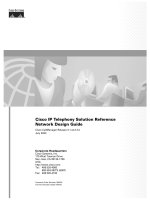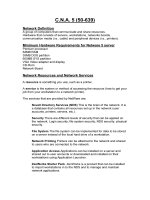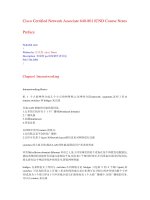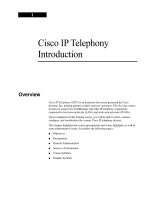Tài liệu Cisco IP Videoconferencing Solution Reference Network Design Guide docx
Bạn đang xem bản rút gọn của tài liệu. Xem và tải ngay bản đầy đủ của tài liệu tại đây (1.53 MB, 114 trang )
Corporate Headquarters
Cisco Systems, Inc.
170 West Tasman Drive
San Jose, CA 95134-1706
USA
Tel: 408 526-4000
800 553-NETS (6387)
Fax: 408 526-4100
Cisco IP Videoconferencing Solution
Reference Network Design Guide
July 2002
Customer Order Number: 956466
THE SPECIFICATIONS AND INFORMATION REGARDING THE PRODUCTS IN THIS MANUAL ARE SUBJECT TO CHANGE WITHOUT NOTICE. ALL
STATEMENTS, INFORMATION, AND RECOMMENDATIONS IN THIS MANUAL ARE BELIEVED TO BE ACCURATE BUT ARE PRESENTED WITHOUT
WARRANTY OF ANY KIND, EXPRESS OR IMPLIED. USERS MUST TAKE FULL RESPONSIBILITY FOR THEIR APPLICATION OF ANY PRODUCTS.
THE SOFTWARE LICENSE AND LIMITED WARRANTY FOR THE ACCOMPANYING PRODUCT ARE SET FORTH IN THE INFORMATION PACKET THAT
SHIPPED WITH THE PRODUCT AND ARE INCORPORATED HEREIN BY THIS REFERENCE. IF YOU ARE UNABLE TO LOCATE THE SOFTWARE LICENSE
OR LIMITED WARRANTY, CONTACT YOUR CISCO REPRESENTATIVE FOR A COPY.
The Cisco implementation of TCP header compression is an adaptation of a program developed by the University of California, Berkeley (UCB) as part of UCB’s public
domain version of the UNIX operating system. All rights reserved. Copyright © 1981, Regents of the University of California.
NOTWITHSTANDING ANY OTHER WARRANTY HEREIN, ALL DOCUMENT FILES AND SOFTWARE OF THESE SUPPLIERS ARE PROVIDED “AS IS” WITH
ALL FAULTS. CISCO AND THE ABOVE-NAMED SUPPLIERS DISCLAIM ALL WARRANTIES, EXPRESSED OR IMPLIED, INCLUDING, WITHOUT
LIMITATION, THOSE OF MERCHANTABILITY, FITNESS FOR A PARTICULAR PURPOSE AND NONINFRINGEMENT OR ARISING FROM A COURSE OF
DEALING, USAGE, OR TRADE PRACTICE.
IN NO EVENT SHALL CISCO OR ITS SUPPLIERS BE LIABLE FOR ANY INDIRECT, SPECIAL, CONSEQUENTIAL, OR INCIDENTAL DAMAGES, INCLUDING,
WITHOUT LIMITATION, LOST PROFITS OR LOSS OR DAMAGE TO DATA ARISING OUT OF THE USE OR INABILITY TO USE THIS MANUAL, EVEN IF CISCO
OR ITS SUPPLIERS HAVE BEEN ADVISED OF THE POSSIBILITY OF SUCH DAMAGES.
Cisco IP Videoconferencing Solution Reference Network Design Guide
Copyright © 2002, Cisco Systems, Inc.
All rights reserved.
CCIP, the Cisco Arrow logo, the Cisco Powered Network mark, the Cisco Systems Verified logo, Cisco Unity, Follow Me Browsing, FormShare, Internet Quotient, iQ
Breakthrough, iQ Expertise, iQ FastTrack, the iQ Logo, iQ Net Readiness Scorecard, Networking Academy, ScriptShare, SMARTnet, TransPath, and Voice LAN are trademarks
of Cisco Systems, Inc.; Changing the Way We Work, Live, Play, and Learn, Discover All That’s Possible, The Fastest Way to Increase Your Internet Quotient, and iQuick Study are
service marks of Cisco Systems, Inc.; and Aironet, ASIST, BPX, Catalyst, CCDA, CCDP, CCIE, CCNA, CCNP, Cisco, the Cisco Certified Internetwork Expert logo, Cisco IOS,
the Cisco IOS logo, Cisco Press, Cisco Systems, Cisco Systems Capital, the Cisco Systems logo, Empowering the Internet Generation, Enterprise/Solver, EtherChannel,
EtherSwitch, Fast Step, GigaStack, IOS, IP/TV, LightStream, MGX, MICA, the Networkers logo, Network Registrar, Packet, PIX, Post-Routing, Pre-Routing, RateMUX,
Registrar, SlideCast, StrataView Plus, Stratm, SwitchProbe, TeleRouter, and VCO are registered trademarks of Cisco Systems, Inc. and/or its affiliates in the U.S. and certain other
countries.
All other trademarks mentioned in this document or Web site are the property of their respective owners. The use of the word partner does not imply a partnership relationship
between Cisco and any other company. (0206R)
iii
Cisco IP Videoconferencing Solution Reference Network Design Guide
956466
CONTENTS
Preface
vii
Purpose
vii
Scope
vii
Audience
viii
Organization
viii
Obtaining Documentation
ix
World Wide Web
ix
Documentation CD-ROM
ix
Ordering Documentation
ix
Documentation Feedback
ix
Obtaining Technical Assistance
x
Cisco.com
x
Technical Assistance Center
x
Cisco TAC Web Site
xi
Cisco TAC Escalation Center
xi
CHAPTER
1
Introduction
1-1
H.323 Basics
1-1
Videoconferencing with H.323
1-2
H.323 Videoconferencing Components
1-3
Video Terminal
1-4
Gatekeeper
1-5
Gateway
1-6
Multipoint Conference Unit (MCU)
1-7
Proxy
1-8
CHAPTER
2
Deployment Models
2-1
Composite Deployment Model
2-1
Campus Single Zone
2-3
Campus Multi Zone
2-4
WAN Single Zone
2-5
WAN Multi Zone
2-7
Contents
iv
Cisco IP Videoconferencing Solution Reference Network Design Guide
956466
CHAPTER
3
Campus Infrastructure
3-1
Network Infrastructure
3-1
Single-Zone Campus
3-2
Multi-Zone Campus
3-3
Quality of Service
3-4
Traffic Classification Types
3-4
Trust Boundaries
3-5
QoS Features Summary
3-6
CHAPTER
4
WAN Infrastructure
4-1
Single-Zone WAN
4-2
Traffic Classification
4-3
Call Admission Control (CAC)
4-4
Provisioning
4-4
Priority Queuing on the WAN
4-4
Entrance Criteria
4-4
Multi-Zone WAN
4-5
Traffic Classification
4-7
Bandwidth Control and Call Admission Control (CAC)
4-7
Provisioning
4-7
Priority Queuing on the WAN
4-8
Entrance Criteria
4-8
CHAPTER
5
WAN QoS
5-1
WAN QoS Model
5-1
Capacity Planning
5-2
QoS Tools
5-2
Traffic Classification
5-3
Proxy Usage
5-3
Traffic Prioritization
5-3
Best Practices
5-5
Call Admission Control
5-6
Contents
v
Cisco IP Videoconferencing Solution Reference Network Design Guide
956466
CHAPTER
6
Dial Plan Architecture
6-1
Dial Plan Components
6-1
Service Prefix Design
6-2
MCU Service Prefixes
6-3
Gateway Service Prefixes
6-3
Single-Zone Dial Plan
6-4
Zone Prefix Design
6-6
Multi-Zone Dial Plan
6-8
CHAPTER
7
Call Routing
7-1
Call Routing Scenarios
7-1
Routing PSTN Calls to H.323
7-4
Routing Inbound PSTN Calls in a Single-Zone Network
7-5
Routing Inbound PSTN Calls in a Multi-Zone Network
7-8
Routing Inter-Zone Calls Using Hopoff Statements
7-8
Routing Inter-Zone Calls Using a Directory Gatekeeper
7-10
CHAPTER
8
Cisco Video Infrastructure Components
8-1
Cisco IP/VC 3540 MCU and Gateway
8-1
Cisco IP/VC 3510 MCU
8-3
Initiating a Call
8-3
Cascading MCUs
8-4
Distributed MCUs
8-5
Video Gateways
8-6
Service Prefixes
8-7
Line Hunting
8-8
Cisco IP/VC 3530 VTA
8-10
Cisco Multimedia Conference Manager (MCM)
8-12
Gatekeeper
8-13
HSRP
8-15
Proxy
8-16
Firewalls and Network Address Translation (NAT)
8-17
Contents
vi
Cisco IP Videoconferencing Solution Reference Network Design Guide
956466
CHAPTER
9
Multi-Zone WAN Case Study
9-1
Network Topology
9-1
Network Design
9-3
Quality of Service (QoS)
9-3
Call Admission Control
9-3
Dial Plan
9-5
Zone Prefixes
9-5
Service Prefixes
9-5
E.164 Addresses and H.323-IDs
9-6
Video Infrastructure
9-7
APPENDIX
A
Resource Reservation Protocol (RSVP)
A-1
G
LOSSARY
I
NDEX
vii
Cisco IP Videoconferencing Solution Reference Network Design Guide
956466
Preface
This preface describes the purpose, scope, intended audience, and general organization of this Cisco IP
Videoconferencing Solution Reference Network Design Guide. It also provides information on how to
order documentation from Cisco Systems.
Purpose
This document provides guidelines, recommendations, and best practices to help you design an
IP videoconferencing solution for your enterprise using the Cisco Architecture for Voice, Video, and
Integrated Data (AVVID).
Scope
This document describes the products and features used to build a Cisco IP Videoconferencing (IP/VC)
system, and it gives recommendations on how to combine those elements into an effective solution for
your enterprise. However, this document does not contain specific implementation or configuration
details for the products and features. For details about a particular product or feature, refer to the
technical documentation available online at Cisco.com. (See Obtaining Documentation, page ix.)
Note
Unless stated otherwise, the solution designs presented in this document require the minimum software
releases listed in Ta ble 1, and the information presented here applies only to those releases.
Table 1 Cisco IP/VC Hardware Platforms and Minimum Software Releases
Platform Minimum Required Software Release
IPVC 3510 Multipoint Conference Unit (MCU) 2.2.1
IPVC 3520 Gateway 2.2.3
IPVC 3525 Gateway 2.2.3
IPVC 3530 Video Terminal Adapter (VTA) 1.0
IPVC 3540 Gateway Module 1.0.9.1
IPVC 3540 Multipoint Conference Unit (MCU) 2.155
Multimedia Conference Manager (MCM) Cisco IOS Release 12.2(8)T
viii
Cisco IP Videoconferencing Solution Reference Network Design Guide
956466
Preface
Audience
Audience
This document is intended for Cisco customers, partners, and systems engineers who will be designing
and implementing an IP videoconferencing solution in the enterprise environment.
Organization
This guide contains the chapters and information listed in the following table.
Note
Cisco strongly recommends that you carefully read chapters 1 and 2 before attempting to design an
IP videoconferencing solution and before reading any other sections of this guide.
Chapter Title Description
1Introduction Presents basic concepts related to IP videoconferencing and the H.323
standard.
2 Deployment Models Describes the primary models used to deploy an IP videoconferencing
solution and explains when to use each model.
Note
This guide makes frequent references to these deployment
models. Cisco recommends that you read this chapter carefully
and understand the main characteristics of each model.
3 Campus Infrastructure Lists considerations and guidelines for deploying IP videoconferencing
with Quality of Service (QoS) in a campus environment (or LAN).
4 WAN Infrastructure Presents considerations and guidelines for deploying videoconferencing
across an IP WAN.
5 WAN QoS Describes key Quality of Service (QoS) features of the Cisco AVVID
network infrastructure and how they apply to IP videoconferencing over
a WAN.
6 Dial Plan Architecture Lists important considerations for designing an effective
videoconferencing dial plan, and explains some of the implementation
mechanisms available.
7 Call Routing Describes the main call routing methods used with Cisco gatekeeper and
Cisco IP/VC equipment in an H.323 video network, and lists guidelines
for using each method.
8 Cisco Video Infrastructure
Components
Describes the various components of the video network infrastructure,
such as the Cisco Multimedia Conference Manager and the Multipoint
Conference Units, and presents guidelines for their use in the enterprise
environment.
9 Multi-Zone WAN Case Study Presents an extended example of a multi-zone WAN implementation that
employs many of the concepts and techniques discussed in this guide.
A Resource Reservation Protocol (RSVP) Gives a few brief recommendations about using RSVP for call
admission control.
ix
Cisco IP Videoconferencing Solution Reference Network Design Guide
956466
Preface
Obtaining Documentation
Obtaining Documentation
The following sections explain how to obtain documentation from Cisco Systems.
World Wide Web
You can access the most current Cisco documentation on the World Wide Web at the following URL:
Translated documentation is available at the following URL:
/>Documentation CD-ROM
Cisco documentation and additional literature are available in a Cisco Documentation CD-ROM
package, which is shipped with your product. The Documentation CD-ROM is updated monthly and may
be more current than printed documentation. The CD-ROM package is available as a single unit or
through an annual subscription.
Ordering Documentation
Cisco documentation is available in the following ways:
•
Registered Cisco Direct Customers can order Cisco product documentation from the Networking
Products MarketPlace:
/>•
Registered Cisco.com users can order the Documentation CD-ROM through the online Subscription
Store:
/>•
Nonregistered Cisco.com users can order documentation through a local account representative by
calling Cisco corporate headquarters (California, USA) at 408 526-7208 or, elsewhere in North
America, by calling 800 553-NETS (6387).
Documentation Feedback
If you are reading Cisco product documentation on Cisco.com, you can submit technical comments
electronically. Click Leave Feedback at the bottom of the Cisco Documentation home page. After you
complete the form, print it out and fax it to Cisco at 408 527-0730.
You can e-mail your comments to
To submit your comments by mail, use the response card behind the front cover of your document, or
write to the following address:
Cisco Systems
Attn: Document Resource Connection
170 West Tasman Drive
San Jose, CA 95134-9883
x
Cisco IP Videoconferencing Solution Reference Network Design Guide
956466
Preface
Obtaining Technical Assistance
We appreciate your comments.
Obtaining Technical Assistance
Cisco provides Cisco.com as a starting point for all technical assistance. Customers and partners can
obtain documentation, troubleshooting tips, and sample configurations from online tools by using the
Cisco Technical Assistance Center (TAC) Web Site. Cisco.com registered users have complete access to
the technical support resources on the Cisco TAC Web Site.
Cisco.com
Cisco.com is the foundation of a suite of interactive, networked services that provides immediate, open
access to Cisco information, networking solutions, services, programs, and resources at any time, from
anywhere in the world.
Cisco.com is a highly integrated Internet application and a powerful, easy-to-use tool that provides a
broad range of features and services to help you to
•
Streamline business processes and improve productivity
•
Resolve technical issues with online support
•
Download and test software packages
•
Order Cisco learning materials and merchandise
•
Register for online skill assessment, training, and certification programs
You can self-register on Cisco.com to obtain customized information and service. To access Cisco.com,
go to the following URL:
Technical Assistance Center
The Cisco TAC is available to all customers who need technical assistance with a Cisco product,
technology, or solution. Two types of support are available through the Cisco TAC: the Cisco TAC
Web Site and the Cisco TAC Escalation Center.
Inquiries to Cisco TAC are categorized according to the urgency of the issue:
•
Priority level 4 (P4)—You need information or assistance concerning Cisco product capabilities,
product installation, or basic product configuration.
•
Priority level 3 (P3)—Your network performance is degraded. Network functionality is noticeably
impaired, but most business operations continue.
•
Priority level 2 (P2)—Your production network is severely degraded, affecting significant aspects
of business operations. No workaround is available.
•
Priority level 1 (P1)—Your production network is down, and a critical impact to business operations
will occur if service is not restored quickly. No workaround is available.
Which Cisco TAC resource you choose is based on the priority of the problem and the conditions of
service contracts, when applicable.
xi
Cisco IP Videoconferencing Solution Reference Network Design Guide
956466
Preface
Obtaining Technical Assistance
Cisco TAC Web Site
The Cisco TAC Web Site allows you to resolve P3 and P4 issues yourself, saving both cost and time. The
site provides around-the-clock access to online tools, knowledge bases, and software. To access the
Cisco TAC Web Site, go to the following URL:
/>All customers, partners, and resellers who have a valid Cisco services contract have complete access to
the technical support resources on the Cisco TAC Web Site. The Cisco TAC Web Site requires a
Cisco.com login ID and password. If you have a valid service contract but do not have a login ID or
password, go to the following URL to register:
/>If you cannot resolve your technical issues by using the Cisco TAC Web Site, and you are a Cisco.com
registered user, you can open a case online by using the TAC Case Open tool at the following URL:
/>If you have Internet access, it is recommended that you open P3 and P4 cases through the Cisco TAC
Web Site.
Cisco TAC Escalation Center
The Cisco TAC Escalation Center addresses issues that are classified as priority level 1 or priority
level 2; these classifications are assigned when severe network degradation significantly impacts
business operations. When you contact the TAC Escalation Center with a P1 or P2 problem, a Cisco TAC
engineer will automatically open a case.
To obtain a directory of toll-free Cisco TAC telephone numbers for your country, go to the following
URL:
/>Before calling, please check with your network operations center to determine the level of Cisco support
services to which your company is entitled; for example, SMARTnet, SMARTnet Onsite, or Network
Supported Accounts (NSA). In addition, please have available your service agreement number and your
product serial number.
xii
Cisco IP Videoconferencing Solution Reference Network Design Guide
956466
Preface
Obtaining Technical Assistance
CHAPTER
1-1
Cisco IP Videoconferencing Solution Reference Network Design Guide
956466
1
Introduction
This chapter provides an overview of the H.323 standard and the video infrastructure components used
to build an H.323 videoconferencing network. It describes the basics of the H.323 video standard and
infrastructure components used throughout this guide.
H.323 Basics
The H.323 standard provides a foundation for audio, video, and data communications across Internet
Protocol (IP) networks. H.323 is an umbrella recommendation from the International
Telecommunications Union (ITU) that sets standards for multimedia communications over local area
networks (LANs). The H.323 standard is part of a larger range of videoconferencing standards (H.32x)
for videoconferencing over various network media. For example, H.320 supports videoconferencing
over Integrated Services Digital Network (ISDN), H.321 supports videoconferencing over
Asynchronous Transfer Mode (ATM), H.324 supports videoconferencing over standard Plain Old
Telephone Service (POTS) lines, and H.323 supports videoconferencing over IP LANs.
The H.323 specification consists of multiple protocols, including:
•
H.245 — Provides control signaling used to exchange end-to-end control messages. These control
messages carry information relating to:
–
Capabilities exchange
–
Opening and closing of logical channels used to carry media streams
–
Flow control messages
–
General commands and indications
•
H.225 — Provides registration, admission, and status (RAS), which is the protocol used between
H.323 devices and the gatekeeper for device registration. The RAS protocol is used to perform
registration, admission control, bandwidth utilization updates, status, and disengagement
procedures between H.323 devices and the gatekeeper. H.225 is also used during call setup to open
a call signaling channel using standard Q.931 messaging protocol.
Table 1-1 lists some of the standards supported by the H.323 specification.
1-2
Cisco IP Videoconferencing Solution Reference Network Design Guide
956466
Chapter 1 Introduction
Videoconferencing with H.323
Videoconferencing with H.323
Historically, videoconferencing was done primarily over ISDN and time division multiplexed (TDM)
networks using standard H.320. Running interactive video over data networks was not an option due to
video’s shared media characteristics, connection-less nature, and lack of guaranteed data flows. With
the introduction of switched 10/100 Mbps networks, high-end routers, and Layer 2 and Layer 3 quality
of service (QoS), delivering interactive video over IP is now a reality. Today there is a large installed
base of H.320 networks that incur large monthly access and switched usage charges.
With the current advances to the IP networks, it is now possible to run interactive video over an IP
network, thus saving customers thousands of dollars a month by converging voice, video, and data traffic
over a common path. Costs drop even further as videoconferencing terminals no longer need to support
complex network aggregation devices such as Inverse Multiplexers (IMUXs) and can instead rely on
simple Ethernet network interface cards (NICs) for network connectivity.
H.323 builds on top of existing IP data networks, ultimately saving money and scaling to larger
deployments. The resulting drop in cost per seat is expected to cause an exponential increase in the
number of H.323 terminals deployed as users move videoconferencing assets from shared areas, such as
conference rooms, to the user desktop. For example, distance learning and business meetings are two
common applications that can be deployed effectively with H.323 over IP networks.
Table 1-1 Protocols Supported by the H.323 Standard
Standard Supported Functions
H.225 RAS, Call Setup and Tear Down (Q.931 call establishment)
H.245 Call Control Messaging
H.261
H.263
Video Formats
G.711
G.722
G.723
G.728
Audio Formats
1-3
Cisco IP Videoconferencing Solution Reference Network Design Guide
956466
Chapter 1 Introduction
H.323 Videoconferencing Components
H.323 Videoconferencing Components
Five components make up an H.323 videoconferencing network:
•
Video Terminal, page 1-4
•
Gatekeeper, page 1-5
•
Gateway, page 1-6
•
Multipoint Conference Unit (MCU), page 1-7
•
Proxy, page 1-8
Cisco offers product solutions for all the above components except video terminals, which are covered
in detail in Chapter 8, Video Infrastructure. Figure 1-1 illustrates a typical H.323 videoconferencing
network.
Figure 1-1 H.323 Videoconferencing Infrastructure Components
MCUs
Cisco IOS based
gatekeeper/proxy
H.323 Video
terminal
Video
terminal adapter
H.320 Video
terminal
Video
gateway
BRI, PRI,
or v.35
PSTN
ISDN
H.323 Video
terminal
74651
1-4
Cisco IP Videoconferencing Solution Reference Network Design Guide
956466
Chapter 1 Introduction
H.323 Videoconferencing Components
Video Terminal
Video terminals come in many forms, including video systems installed on PCs as standalone desktop
terminals and group-focused shared conference room devices. Figure 1-2 illustrates the functional
components in an H.323 video terminal.
Figure 1-2 Functional Components of a Video Terminal
Video conferencing
user interface
System control
H.245 Control
Q.931
Call setup
H.225 RAS
gatekeeper
interface
74652
Data
interface
T.120
Camera
display
Video codec
H.261
H.263
Microphone
speakers
Audio codec
G.711
G.723
G.729
RTP
LAN interface
1-5
Cisco IP Videoconferencing Solution Reference Network Design Guide
956466
Chapter 1 Introduction
H.323 Videoconferencing Components
Gatekeeper
The gatekeeper is one of the most important components of an H.323 videoconferencing network.
Although the H.323 standard lists the gatekeeper as an optional device, you cannot build a scalable video
network without the application controls the gatekeeper provides. Each video infrastructure component
registers with the gatekeeper. The gatekeeper performs all address resolution, bandwidth management,
admission control, zone management, and intra-zone and inter-zone call routing.
A zone is a logical grouping of H.323 infrastructure components registered to, and managed by, a single
gatekeeper. Zones are not dependent on physical network topology or IP subnets. Zones, which may span
one or more network segments or IP subnets, are simply a logical grouping of devices. As such, zones
can be defined based on geographical proximity, bandwidth availability, or other criteria.
The most fundamental function of a gatekeeper is to provide address resolution, thus allowing terminals,
gateways, and MCUs to be addressed using the international E.164 address standard and/or an H.323
alias. Each endpoint that is registered to a gatekeeper must be assigned a unique E.164 address (numeric
identifier). As a result, zone prefixes are used in the H.323 video network to identify zones, similar to
the use of area codes in telephony systems.
Throughout this document are example topologies that are based on single-zone and multi-zone
configurations. For example, Figure 1-3 illustrates a single zone.
Figure 1-3 Single H.323 Zone
MCU
Gatekeeper
H.323 Zone
H.323
Endpoint
Video
gateway
PSTN
ISDN
74653
1-6
Cisco IP Videoconferencing Solution Reference Network Design Guide
956466
Chapter 1 Introduction
H.323 Videoconferencing Components
Gateway
Gateways provide interoperability between H.323 elements and an installed base of H.320 units. The
H.323 gateway allows H.323 video terminals to communicate with other H.32x video terminals, such as
H.320 and H.321 video terminals. Video gateways perform translation between different protocols,
audio encoding formats, and video encoding formats that may be used by the various H.32x standards.
For example, the ISDN H.320 standard uses the H.221 protocol for signaling, while the H.323 standard
uses H.225. The gateway must translate between these two protocols to allow devices of different
network media and protocols to communicate with each other. Figure 1-4 illustrates the role of a gateway
in an H.323 video network.
Figure 1-4 Functional Components of an H.323 Video Gateway
74654
IP Terminal
processing
ISDN/PSTN
Processing
Transmission and communication
format translation
H.245/H.242
H.225/H.221
Audio transcoding
G.711/G.722
G.711/G.723
G.711/G.728
PSTN
ISDN
H.320
Video terminal
H.323
Video terminal
1-7
Cisco IP Videoconferencing Solution Reference Network Design Guide
956466
Chapter 1 Introduction
H.323 Videoconferencing Components
Multipoint Conference Unit (MCU)
Video terminals are generally point-to-point devices, allowing only two participants per conversation. A
multipoint conference unit (MCU) allows video conferences to be extended to three or more participants.
An MCU consists of a multipoint controller (MC) and a multipoint processor (MP). The MC manages
all call setup control functions and conference resources as well as the opening and closing of media
streams. The MP processes audio and video media streams only. Cisco MCUs can be stacked to create
more conferences or cascaded to create larger conferences. Stacking and cascading are covered in detail
in Chapter 8, Video Infrastructure. Figure 1-5 illustrates the function of an MCU.
Figure 1-5 Functional Components of an MCU
74655
Multipoint controller
call setup resource
management redirection
Conference control
MCU
LAN Interface
Multipoint processor
audio and video mixing
H.323
Video terminal
H.323
Video terminal
H.323
Video terminal
1-8
Cisco IP Videoconferencing Solution Reference Network Design Guide
956466
Chapter 1 Introduction
H.323 Videoconferencing Components
Proxy
A proxy is a call processing agent that terminates H.323 calls from a local LAN or zone and establishes
sessions with H.323 endpoints located in other LANs or zones. In so doing, the proxy provides network
administrators with the ability to set and enforce quality of service (QoS) on inter-zone segments. The
proxy also provides a method of identifying H.323 videoconferencing connections for tunneling through
firewalls and Network Address Translation (NAT) environments. Figure 1-6 illustrates a proxy call over
a WAN link.
Figure 1-6 Proxy Call Over a WAN Link
H.323 Video
terminal 1
H.323 Video
terminal 2
Gatekeeper
proxy
Qos-Enabled
IP WAN
Leg 1 -
Terminated call from
video terminal 1 to proxy
Leg 2 -
QoS-Enabled call from
proxy to proxy with IP
precedence 4 or RSVP
Leg 3 -
Terminated from proxy
to video terminal 2
Gatekeeper
proxy
74656
CHAPTER
2-1
Cisco IP Videoconferencing Solution Reference Network Design Guide
956466
2
Deployment Models
This chapter introduces four basic design models used to deploy IP videoconferencing solutions:
•
Campus Single Zone, page 2-3
•
Campus Multi Zone, page 2-4
•
WAN Single Zone, page 2-5
•
WAN Multi Zone, page 2-7
This chapter provides basic design criteria and guidelines for selecting the correct deployment model.
Subsequent chapters of this design guide describe in more detail each of the basic models introduced
here.
Composite Deployment Model
Figure 2-1 illustrates a composite topology that encompasses all of the deployment models discussed in
this guide. All designs discussed in this chapter are supported with currently shipping products.
The overall goals of a Cisco-based H.323 videoconferencing solution are as follows:
•
Provide end-to-end IP video connectivity across the corporate infrastructure, with business quality
transmission. Business quality video is defined as 30 frames per second operation with a minimum
of Common Intermediate Format (CIF) resolution. Typically, this level of quality requires 384 kbps
of application bandwidth for most video terminals.
•
Provide quality of service (QoS) — high availability with low latency and jitter (delay variability).
•
Reduce Integrated Services Digital Network (ISDN) costs by eliminating the need for ISDN
attachments directly to video terminals.
•
Allow Public Switched Telephone Network (PSTN) access to legacy H.320 systems through shared
gateway resources.
•
Support multipoint calling through Multipoint Conference Units (MCUs).
•
Conserve WAN bandwidth by distributing MCU and gateway resources across the IP infrastructure.
•
Lower total cost of ownership for the video network by utilizing the existing IP infrastructure.
•
Support manageability of multiple H.323 elements in a distributed network topology.
2-2
Cisco IP Videoconferencing Solution Reference Network Design Guide
956466
Chapter 2 Deployment Models
Composite Deployment Model
Figure 2-1 Composite Deployment Model
74657
Si
Si
Si
H.323
Terminals
H.323
Terminals
MCU
MCU
Gatekeeper
proxy
Gatekeeper
proxy
H.323
to H.320
Gateway
H.323
to H.320
Gateway
H.320
MCU
H.320
Endpoints
PSTN
ISDN
QoS Enabled
IP WAN
Large branch
with one or
more zones,
local PSTN, and
MCU access
Headquarters with one or
more zones, and local
PSTN and MCU access
Small branch
with no local gatekeeper,
PSTN or MCU services.
All services will be handled
at headquarters site
2-3
Cisco IP Videoconferencing Solution Reference Network Design Guide
956466
Chapter 2 Deployment Models
Campus Single Zone
Campus Single Zone
Figure 2-2 illustrates an H.323 network in a campus environment configured with a single zone. This is
the most basic design model to implement and is used in pilot installs and smaller video environments.
Figure 2-2 Campus Single Zone
The campus single-zone deployment model has the following design characteristics:
•
A single gatekeeper supporting a single zone for H.323 video.
•
All H.323 video users registered with the single gatekeeper. (See Chapter 8 for gatekeeper
registration limits.)
•
Optional PSTN access available through the Cisco IP/VC 352X gateway.
•
Optional multipoint conferencing available through the Cisco IP/VC 3510 MCU.
•
Zone bandwidth managed by the configured gatekeeper.
•
All gateway and MCU services registered and managed by a single gatekeeper.
•
Call routing between endpoints using fully qualified E.164 addresses or H.323-ID.
Si
Si
Campus
backbone
74658
Si
Si
MCUs
Gateway
Gatekeeper
Video Infrastructure
PSTN
ISDN
Buidling 1
H.323 Video
terminals
Si
Si
Building 2
H.323 Video
terminals
2-4
Cisco IP Videoconferencing Solution Reference Network Design Guide
956466
Chapter 2 Deployment Models
Campus Multi Zone
Campus Multi Zone
Figure 2-3 illustrates a multi-zone H.323 video network in a campus environment. This model is most
often implemented in an enterprise campus network. Depending on business function, administrators
may choose to create different zones for security reasons. For example, company executives may be
registered in a single zone that is separate from other users to allow administrators to limit access to those
video terminals. In addition, as a video network grows, a single zone may not be manageable because of
the number of users or the ability to manage network resources.
Note
Multiple zones can be configured on a single router. If you configure multiple local zones on a single
router, and MCUs and/or gateways are registered with the zones, you must add hopoff statements for
each service prefix. If hopoffs are not added for each service prefix, the video terminal will not be able
to access MCUs or gateways outside its local zone. See Routing Inter-Zone Calls Using Hopoff
Statements, page 7-8, for more information.
Figure 2-3 Campus Multi Zone
Video infrastructure
Si
Si
Campus
backbone
74659
Si
Si
MCUs
Gateway
Gatekeeper
Gatekeeper
Zone 1Zone 2
Video Infrastructure
PSTN
ISDN
Si
Si
2-5
Cisco IP Videoconferencing Solution Reference Network Design Guide
956466
Chapter 2 Deployment Models
WAN Single Zone
The campus multi-zone deployment model has the following design characteristics:
•
Multiple gatekeepers supporting multiple zones for H.323 video.
•
H.323 endpoints register with one of the multiple gatekeepers. (See Chapter 8 for gatekeeper
registration limits.)
•
Bandwidth management for each zone and between zones is controlled by configured gatekeepers.
•
Optional PSTN access available through Cisco IP/VC 352X gateway.
•
Gateway and MCU services are registered and managed across multiple gatekeepers.
•
Gateway and MCU services may be distributed throughout the campus.
•
H.323 users and services are segmented for security, bandwidth control, and resource allocation.
•
Intra-zone and inter-zone call routing using fully qualified E.164 address or H.323-ID.
WAN Single Zone
Figure 2-4 illustrates a single-zone H.323 video network in a WAN environment. This deployment model
is used when remote sites have a small number of video endpoints, usually no more than one or two at
each remote site on a T1 WAN link. From a management or economic standpoint, it might not make
sense to create a zone at each remote site for one or two video terminals. Call admission control (CAC)
across the WAN is not usually an issue with only one or two video terminals at each remote site, but it
is an issue when the number of remote endpoints exceeds the provisioned video bandwidth.
In the absence of a gatekeeper, implement quality of service on the WAN ports by using one of the
following methods:
•
Priority queuing on traffic classification IP Precedence 4, or Differentiated Services Code Point
(DSCP) AF41
•
Access control list (ACL) for each video terminal at the remote site, to direct the video streams to
the appropriate priority queue









